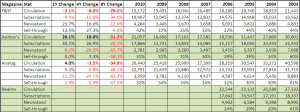It’s widely known that total circulation (sales) numbers for the main science fiction and fantasy magazines have been dropping for years. For example, in 1983 Analog’s circulation was around 115,000. Asimov’s and Magazine of Fantasy and Science Fiction, while not that high, were in the same general ball park. A lot has changed since then. Sales took a huge hit in the early 1990’s and continued to drop almost every year. However, last year something wonderful happened. Numbers went up.
Gardner Dozois, in his summation of the SFF industry for 2010, found in The Year’s Best Science Fiction Vol 28, from which 2010 and 2009 numbers were taken, mentions that the growth numbers for Asimov’s subscriptions were driven in large part by “digital copies sold for e-readers through devices such as the Kindle,” and that Analog’s increase in subscriptions was “also largely because of digital sales.”
We all know that ebook took off last year. It will be very interesting to see the increase in total circulation continues for these magazines in 2011. Here is the supporting data that was collected from the reports in The Year’s Best Science Fiction volumes 20 – 28. Total circulation is made up of subscriptions and newsstand sales. Sell-through is a measurement of the % of the copies displayed in newsstands (at Barnes & Noble etc.) which sold. I added the Realms of Fantasy figures just so we could see, with the magazine recently dying its third death, just how big it once was.
Of course, a fascinating question is: what are the chief factors that led to such a drastic decline in the first place? But I don’t know anyone who has been able to provide data to suggest what the chief cause(s) are. If anyone knows of one, please post in the comments.
Wikipedia: Analog Science Fiction and Fact,

















Personally, I always thought at least one factor for the decline was the end of the space race. Without such a big science fiction draw in the public eye to spur interest, they slackened off.
Hum, interesting theory.
I personally let my subscription lapse when I was so busy that I found I was almost 1 year behind in reading the issues. Maybe my situation was unique or perhaps culturally we are reading less? I also wonder about the younger generation. Is there a sufficient draw to attract that demographic into the genre? If not, then perhaps there is a certain degree of natural attrition at work. (As Colton alluded to, do kids dream about being astronauts anymore?)
I don’t know if they do. But I can tell you they dreamed of going to Hogwarts the last decade.
And literacy rates have been rising for the last years. Rowling had a lot to do with that in the younger ages in the late 90’s and early 2000’s. Stephenie Meyer continued it and spawned a whole new YA Paranomal Romance genre, which has become big enough that Barnes & Noble now breaks it out. Go to the stores and you see Teen Fiction, YA Paranormal Romance, and YA Fantasy and Adventure. Those categories are growing.
Is it that the culture has no demand for SFF in short form, or that these magazines cater to an adult market? And maybe one that eschews the very stories that YA readers love.
Kris Rusch raises that question in her essay “Barbarians at the Gate” in Asimov’s: http://www.asimovs.com/_issue_0612/thoughtexperiments.shtml
Lots of speculation. No data.
Literacy rates: http://johndbrown.com/2009/03/literary-reading-rates-on-the-rise/
Total speculation here, BUT… I wonder if some of the decline is due to the prevalence of science fiction-ish technology in our lives these days. Tiny communication devices, for example, are no longer something to oooh and ahhh at on the big screen or in the pages of a magazine; we don’t really get the same sense of wonder from them anymore. (Though that same prevalence of technology is perhaps all the more reason and need for us to have people writing about the possible future effects and consequences of that technology… more need, but less people reading it?)
Another possible factor is the blurring of the scifi and fantasy lines, how so much fantasy seems to have a scientific (or pseudo-scientific) underlay. I’d be interested to hear further thoughts on all this.
S. Jeanne,
I don’t know why the magazines made their big slide, but I don’t think SF & Fantasy has gone out of fashion or become less popular. There are boom-and-bust cycles with fiction genres. But we’re not looking at the genre as a whole here, just magazine subscriptions.
There were lots of big grossing SF movies in the 1990s and 2000s.
http://en.wikipedia.org/wiki/List_of_science-fiction_films_of_the_1990s
http://en.wikipedia.org/wiki/List_of_science-fiction_films_of_the_2000s
I don’t know about SF book sales, but if you look at books like the big selling HUNGER GAMES and UGLIES series (and others), SF has not gone away.
Potter started a up a huge fantasy boom cycle. Meyer started up a huge paranormal romance boom. Hunger games started a SF dystopia boom. Not as big as those two, but significant.
So I don’t know that we can say that SF and Fantasy is less popular. We can say that the magazine format is. But that may have more to do with the format than anything else. And maybe the timing–a recession, the rise of the internet, pc, and video games–all helped hasten the magazine bust. But I don’t know if that says anything about SF interest in general.